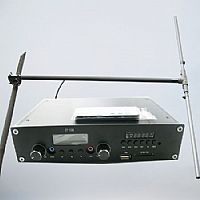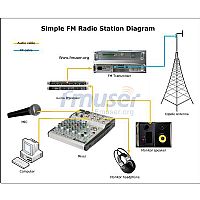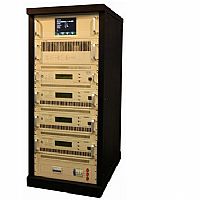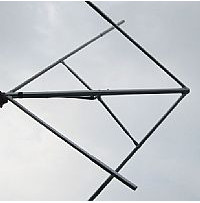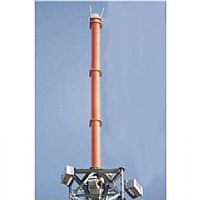A nice AC mains powered transmitter with pre-emphasis, audio level control, and tuning control.
Notice: Before operating a radio transmitter, find out what kind of transmitter operation, if any, is permitted in your locality. Radio transmitter operation is a serious legal matter. In the United States, operation of unlicensed intentional radiators is covered by Part 15 of Title 47 of the Code of Federal Regulations. This design can be readily adapted to different frequencies and different power levels. If you choose to build and operate the transmitter described here, you do so at your own risk. I'm only publishing this as an example of what can be done.

The circuit board above was built by Mr. Mike Rogers of the U.K.
He used two BC109 transistors Q1 and Q7 (see the schematic below),
four 2N2222 transistors for Q2, Q3, Q4, and Q5, and a BF199
in place of the MPSH34. A photo and description of Mr. Roger's
implementation is further down this page.
Also on this website, see page titled Battery operated FM rebroadcast transmitter.
This transmitter was built for some relatives who stayed with us for a while. The husband is hard of hearing and his wife called me from a Radio Shack store where she was about to buy a radio transmitter so her husband could listen to the television using headphones, and wanted some advice about whether she would need an adapter for the audio connection. This was crazy. Here I am building just these sorts of things for fun, and she was buying one. That's how this project got started. It is one of the few things that I've built that didn't look too far out of place inside the home (well, at least behind the television). It was enclosed in a black plastic box with a marked front panel sporting stylish controls for adjusting the audio drive level and tuning the transmitter, jacks for the audio input and the antenna, and even a pilot light so the would know it was plugged in. I don't have a way to get a picture of it, so there is no picture here, and the construction details were written from memory.
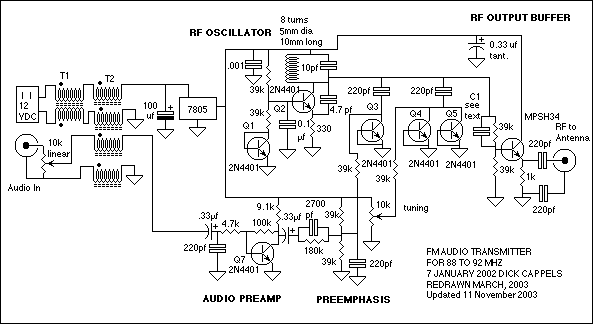
The pilot light is not shown in the schematic. It was powered from the 5V supply.
Revision note: Many sincere thanks to Mr.Azhar H.Shah of Pakistan for sorting out and telling me about errors that cropped in this schematic up when the schematic was redrawn in March of 2003. These errors were corrected in the 11 November 2003 updated version..
The circuit
The circuit consists of a frequency modulated oscillator, an audio preamplifier with pre emphasis to supply the frequency modulating signal, and a buffer amplifier to drive the antenna connector.
Oscillator's frequency is determined by L1 resonating with the 10 pf capacitor and the total capacitance across it. The collector-base capacitance of the transistors Q3, Q4, and Q5 is a function of their revers bias. This is basically a poor man's (or lazy man's) varactor. The voltage across Q3 is set by a voltage divider and is then modulated by an Ac coupled audio signal from the pre amp, causing the reverse bias to vary with the audio signal, which changes the resonant frequency of L1's circuit, causing the frequency of the oscillator to vary with the audio signal.
The capacitance of Q4 and Q5 is adjusted by DC bias from the tuning adjustment potentiometer, and this capacitance sets the center frequency of the oscillator.
All of the transistors in the oscillator -Q1 through Q5, are 2N4401.
The purpose of the buffer is to minimize frequency shift as loading on the antenna is changed. It was specifically designed to reduce the signal amplitude to the antenna. Transmitters should not use any more power than is necessary to achieve the task at hand, and lightly coupling the RF into the buffer's base with a gimmick capacitor did the trick. The transistor is an MPSH34.
The audio pre amp that drives the frequency modulation state is a single inverting transistor. The open loop gain of Q7 is about 150 (mostly set by the voltage across the collector resistor) and the closed loop gain of the stage is about 20 (set by the ratio of the 100k feedback resistor to the 4.7k input resistor). A pre emphasis network is flat from about 3 Hz to 350 Hz, then the response increases at 6 db/octave until it levels off around 3 kHz. This particular network was selected by me to make my CDs sound good on the portable radio I was using at the time. It doesn't conform to either the British or American FM radio preemphesis curve.
Do I need to point out that the power supply is DC from a mains-powerd power supply (please don't use a switching power supply for this unless you are adventurous) and the voltage is regulated to +5V with an LM7805 T regulator.
Construction
Build this on a ground plane board. Layout is important. If you place the parts relative to one-another in correspondence with their placement on the schematic, it should work pretty well. I built this one "dead bug" style, in which the components are mounted legs up. The grounded components are soldered directly to the ground plane, and its these components that hold everything together. The resulting assembly can be fairly rugged if the leads are kept short, which is always a good idea when building circuits that operate at high frequencies.
The inductor is made by winding 8 turns of #24 insulated solid copper wire on a 5 mm screwdriver. I used a conductor from a piece of category-5 quad twisted pair, left over from wiring the house with Ethernet and this seems to work well and to be easy to handle.
C1, the capacitor that supplies the signal to the base of the output buffer transistor is a gimmick capacitor. A gimmick is made by tightly twisting two pieces of wire together and cutting it to size. Its a nice way to make a small capacitor where the actual value isn't critical. I've also used gimmicks to use as tuning capacitors. Twist up a length of capacitor and clip it shorter and shorter until the circuit is tuned. The problem with that approach is that you may have to make a few of these in order to learn what the optimum length is.
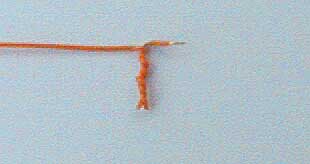
Nothing much to it. A quick, easy, and adjustable low value capacitor.
For this transmitter, Try about 10 twists on the gimmick. The purpose is to make sure that some RF gets coupled into the buffer's base, but not too much. If you want the signal to be smaller, cut off some of the length of the gimmick.
The two chokes, T1 and T2 are common mode RF chokes. I had some Ferroxcube EC-41-3C8 E cores around and they worked just fine. Other ferrite cores should work well too. 3C8 is very lossy at these frequencies -the material was originally designed for use in audio filters and adapted to power supply use, but this is not a critical application and it seems to work well.
These cokes don't work if the input (left) end of the coils couple capacitively to the output (right) end of the coils, and the best way to avoid this is to wind it in a single layer.
T1 is about 8 turns of wire, two-in-hand, in a single layer on one half of an EC-41 core. More turns might have been better, but this is all that would fit in a single layer.
T2 is similar to T1 in that it is 6 to 10 turns, single layer, but this time it was four-in-hand. Use any wire you have handy. I think I used some more of the #24 insulated solid copper wire for this too.
Before tuning up
Apply power.
Check to see that the output of the 5V regulator is about 5 volts.
Check to see if the oscillator is oscillating. The RF probes described on other pages on this site are very helpful for this. Indeed, this is what they are for.
Check to see if the audio pre amp is working. It should have a gain of about 20.
Here are some voltages to expect around the circuit:
Q2 Base 2.4V, Emitter 1.8V, Collector 5V
Q3 Collector 2.5V
Q4,5 Collector 0-5V; the same as the tuning pot wiper
Base of the MPSH34 will be between 1.5 and 2.5 volts
Tune-up
The tuning range of the transmitter is adjusted by stretching or compressing, or adding or removing a turn on L1. In your particular layout, you might even have to add or remove a turn from the coil. you can use and FM radio receiver as a reference for adjusting the turning range (see the note below about FM receivers). Tune the receiver to a clear spot on the dial around 90 MHz. The idea is to adjust the coil so that the transmitter oscillates at this frequency when the tuning know is set to the center of its range. Before you can adjust the coil, you need to find out whether the oscillator is running at to high of a frequency or too low. If you can hear the oscillator go by as you adjust the tuning knob,the hiss in the receiver will become noticeably less when the transmitter is tuned to the receive frequency, or you will hear thump if you tune through quickly, adjusting the coil will be fairly easy.
If the oscillator is heard when the voltage on the wiper of the tuning pot is above 2.5 volts, the oscillator's range is too low, and this can be corrected by compressing the coil or adding a turn. On the other hand, if the oscillator is heard when the voltage on the wiper of the tuning pot is below 2.5 volts, the oscillators' range is too low and this means that the coil needs to be stretched a little or have a turn removed. If the oscillator frequency is way too high, that is, too high for the tuning knob to bring the signal down to the receiver's frequency, you can help things out by touching your finger to L1 to add additional capacitance. If the frequency is too low, you will need to try stretching the coil to try and raise the frequency range.
Things that might go wrong (not counting basic construction errors)
Hum in the received signal. This could be RF getting back into the DC power supply. Here are some ideas: Replace the power supply with one that has decoupling capacitors (like 1000 pf) across each of the rectifiers. You might have to rewind T1 using a different core or more turns. If you have the transmitter or the audio source powered from a wall socket driven by a light dimmer, try a different outlet. it might be necessary to use and additional common mode choke in series with the audio input lead. Make sure that the windings on T1 and T2 are properly phased with respect to one-another -check the phasing dots on the schematic.
A note about FM receivers
Be careful when using digitally tuned transistor radios to adjust the tuning range of this transmitter. Many of the modern low-cost digitally tuned portable FM receivers are just terrible when it comes to tuning false images in the presence of strong signals. An image is basically the desired signal being received while the receiver thinks its looking at a different frequency. In a single conversion superheterodyne receiver, incoming signals are mixed with a local oscillator to produce an intermediate frequency. Unfortunately, two different incoming frequencies are capable of producing the intermediate frequency. One is the Local Oscillator + the Intermediate Frequency, and the other is the Local Oscillator - the Intermediate Frequency. The receiver is supposed to be able to discriminate between the two by tuning a resonant filter between the antenna and the stage that the mixing takes place in. When strong signals are present they get through the resonant filter, even if they are far removed from the frequency the receiver is tuned to. That's one kind of image to look out for, and every single conversion receiver has one. Digitally tuned single conversion receivers, which is what a lot of these cheap digitally tuned receivers on the market today are, have many more frequencies and harmonics running around in them, probably as a result of the frequency synthesizer used to generate the Local Oscillator signal, but maybe also from microcontroller clock signals as well. A strong signal, such as you are likely to get with this transmitter within a few meters, can show up many places on the receiver's "dial". So be aware of these phenomena while tuning up the receiver. Use the smallest antenna practical for adjusting the receiver's tuning range, and look around the dial to see if the transmitter shows up more than one place, and if it does, go for the strongest signal.
.
An example of one implementation of the transmitter.
Mr. Mike Rogers of the U.K. built this transmitter and put it inside a Digital Audio Broadcast Receiver, which he uses in his home. Its a very tidy and handy little repeater station in a single box. Mr. Rogers commented "...it adds that one vital DAB channel to the nomal repertoire of FM channels..."

Within the extremely neat assembly, you might notice the white wire near the upper-right corner of of the circuit board. That's the antenna for the transmitter -only several cm long.
Our other product:




